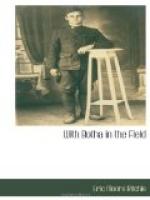In the meantime the authorities had decided we must find water in the rear; for that purpose a party was at once despatched to Gawieb, in the Swakop River bed. It was found by a party from the Commander-in-Chief’s Bodyguard, and at the Gawieb Hole the greater part of the forces watered that night. And they took seven hours to do it.
Before sundown General Botha, with Staff and Bodyguard, fell back two miles on the Husab-Riet Road and camped there for the night. Scarcely had the Headquarters party arrived before news came that the enemy was in precipitate flight, had evacuated Riet and had blown up his small ammunition and railway water-tanks at the Riet terminus of the narrow gauge railway line to Jakalswater. Bodies of the Union troops had occupied Riet on the evening of the 20th.
The actions at the Jakalswater and Pforte fronts, to fight which the columns had swept away to our left the night before, were equally successful.
That is the general story of the fight of the 20th March on the inland edge of the Namib Desert. But how to picture vividly the scene before Riet that day? At dawn in those parts conditions are bearable enough; the sun has little strength; the night wind refreshes. From 6.30 till 10 o’clock the desert is endurable. Then comes the change. All along the front the stark yellow sand is taking on a different hue under the climbing sun rays. It turns almost to glaring whiteness all around—to where it stops short at the foot of those scorched and smothered rocks on the left flank. To our right the members of the Headquarters Staff are standing—sitting—resting. An officer brings his glasses down slowly, blinks, feels for a pipe, lights it. Another moves head and extended arm to the right and makes a remark to a colleague. Along the ridge we occupy the Bodyguard are standing-to and watching the action; you see that fellow wearily ease a heavy bandolier; further down another brings an army biscuit from his haversack and breaks it on his boot.
And now look at that little group almost straight ahead of us; as the tall Chief-of-Staff moves aside you see a figure on a little camp stool. The left hand is just under the hip, binoculars are in the right; up go both hands with the glasses; down they come. He speaks to the Chief-of-Staff; there is the favourite gesture—the arm is jerked out horizontally, the hand pointing loosely, and dropped again. The face is powdered with fine sand and dust; during the day he has been allowed a small beaker of water from the artillery. A favour indeed. That is Botha—Louis Botha, Commander-in-Chief, the man who leads us. And on either flank, well screened, little knots of men are grouped round the guns—and “Hampang-ky-yao!” they go in our ears, their report carrying ten miles back into the desert where our transport hears them in muffled thunder. And look up as you hear that screeching whistle. The enemy’s shells burst in the depression behind us on both flanks—




